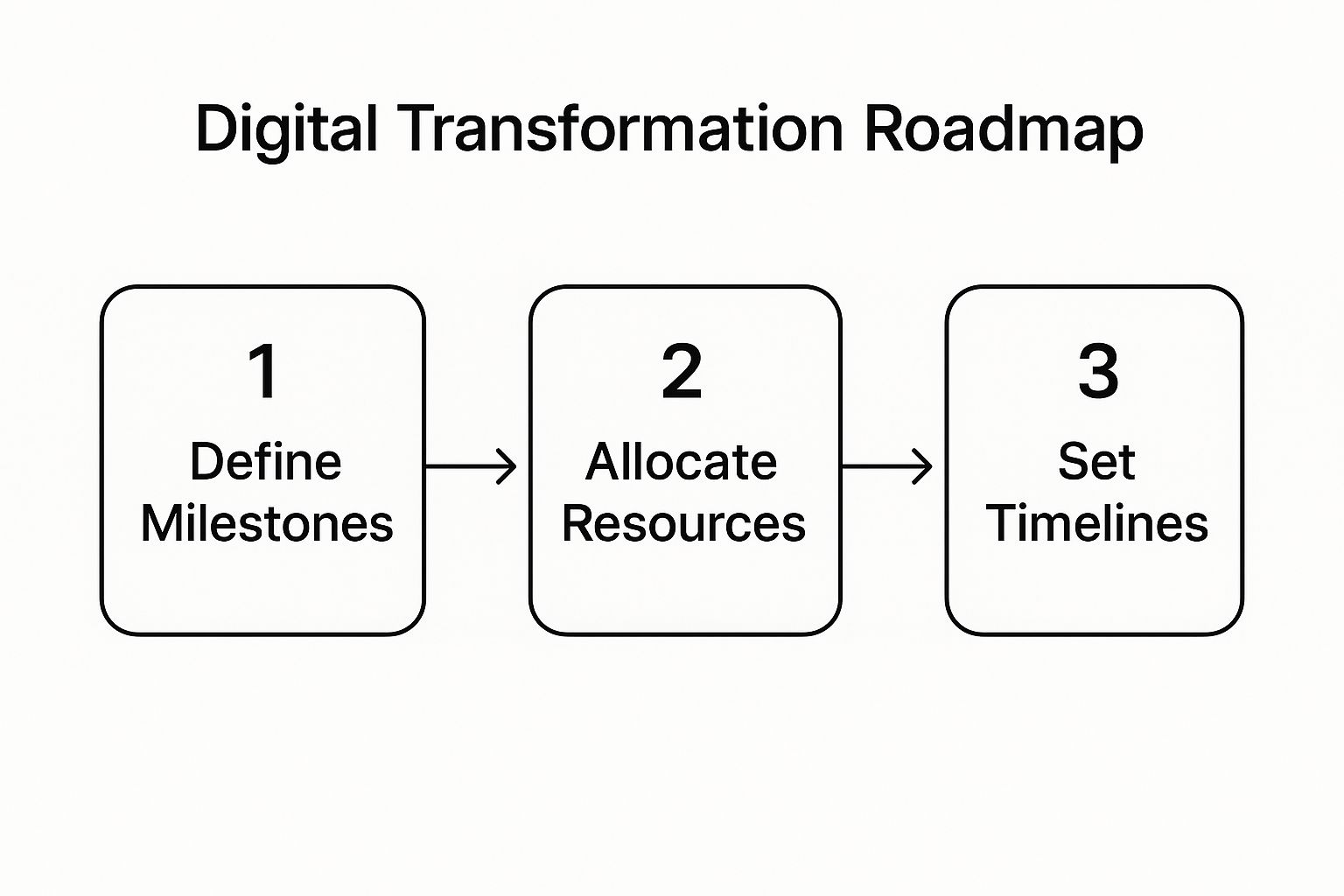A digital transformation roadmap is your company’s strategic blueprint for bringing in new technologies and processes. It’s a high-level plan that lays out why you’re changing, what specific moves you’ll make, and how you’ll track success to improve operations, make customers happier, and get a leg up on the competition.
Your Digital Transformation Starts Here

Let’s cut through the corporate jargon. A digital transformation roadmap isn’t just another project for the IT department. It’s a full-on business revolution—your ticket to staying relevant. Think of it less as a rigid set of instructions and more as a living map that guides your entire organization toward a smarter, more agile future.
This isn’t about chasing every shiny new tech trend. It’s about making deliberate, strategic choices that solve real problems and create actual value. Without a clear plan, these efforts often become expensive, disconnected projects that go nowhere fast. A solid roadmap ensures every initiative, from adopting AI to rethinking workflows, is tied directly to a core business goal.
The Urgency of Now
So, why the big rush? Because customer expectations and the market itself have completely changed. People now expect seamless, personal, and instant experiences in every interaction, whether they’re buying a coffee or managing a global supply chain. Old-school legacy systems and clunky processes just can’t keep up.
This pressure is fueling a massive economic shift. The global digital transformation market, valued at a staggering USD 1.18 trillion, is projected to explode to USD 10.76 trillion by 2034. This growth isn’t just a number; it’s a signal driven by the universal need to adapt or be left behind. You can see the full breakdown in this digital transformation market report.
A digital transformation roadmap exists to provide clarity and direction. It gets everyone—from the C-suite to the front lines—on the same page, turning a complex, intimidating process into a series of manageable, impactful steps.
A well-defined roadmap isn’t just a document; it’s a shared understanding that aligns your entire team. To give you a better sense of what this looks like, here’s a quick breakdown of its core pillars.
Core Pillars of Your Transformation Roadmap
| Pillar | What It Really Means | Why It’s Non-Negotiable |
|---|---|---|
| Clear Objectives | Defining what “success” looks like in business terms, not tech jargon. Think “reduce customer churn by 15%” not “implement a new CRM.” | Without a destination, any road will get you there—or nowhere. Clear goals prevent scope creep and wasted resources. |
| Current State Assessment | An honest, no-holds-barred look at your current tech, processes, and people’s skills. What works? What’s broken? | You can’t plan a route without knowing your starting point. This identifies the real problems you need to solve. |
| Initiative Mapping | Connecting specific projects (like a new e-commerce platform) directly to your objectives (like increasing online sales). | This ensures every dollar and hour spent is moving you closer to your goals, preventing “pet projects.” |
| Ownership & Accountability | Assigning a real person to be responsible for each initiative’s success. | Ideas without owners are just wishes. Accountability drives execution and ensures someone is steering the ship. |
| Success Metrics | The numbers that will tell you if you’re winning. These are the KPIs you’ll live and breathe by. | If you can’t measure it, you can’t manage it. Metrics prove ROI and tell you when to pivot. |
These pillars form the foundation of any plan that actually delivers results, moving you from wishful thinking to tangible progress.
A Real-World Scenario
Imagine a mid-sized manufacturing company, let’s call them “BoltWorks,” that’s been a market leader for 50 years. Their entire operation runs on paper work orders, manual inventory tracking in massive spreadsheets, and a customer service team that has no integrated data on past orders.
They’re facing some serious challenges:
- Production Delays: Finding an order’s status means physically digging through folders, leading to painfully slow response times.
- Inventory Waste: Inaccurate stock counts mean they over-order some parts while running out of critical ones, bringing production to a halt.
- Customer Frustration: Clients have to repeat their entire history with every single call, making them feel completely undervalued.
BoltWorks’ leadership realizes their competitive edge is slipping away. A digital transformation roadmap is their only path forward. It’s not about buying flashy new software; it’s about fundamentally rethinking how they work to fix these specific, costly problems.
The People Behind the Plan
It’s a classic mistake to see this journey as purely a tech problem. But the most critical piece of the puzzle is the human one. Successfully navigating this kind of change requires careful planning and communication to bring your team along for the ride.
You have to manage expectations, provide proper training, and build a culture that actually embraces new ways of working. Ignoring the people side is one of the top reasons why these initiatives fail. For a deeper look, our guide on using a change management process template is a great resource for supporting your team.
Ultimately, this roadmap is your guide to not just surviving, but building a more resilient, efficient, and customer-obsessed organization.
Defining Your Vision and Current Reality

You wouldn’t start a road trip without a destination, right? In the same way, a digital transformation roadmap is just a fancy document without a crystal-clear vision of where you’re actually going. This is the part where you get to dream big but also get brutally honest about your starting point.
The goal here is to craft a future-state vision that gets everyone, from the newest hire to the CEO, genuinely excited.
This vision isn’t just about cool new tech; it’s about business outcomes. Are you trying to completely reinvent the customer journey? Do you want to eliminate soul-crushing operational waste? Maybe you’re aiming to create entirely new revenue streams. Your vision has to be compelling, specific, and tied to real business goals. Forget vague statements like “become more digital.”
Instead, think in tangible achievements. A solid vision statement answers the question, “What will be different and better when we pull this off?” It becomes the North Star that keeps your entire digital transformation roadmap on track, especially when things get tough.
Crafting Your Transformation Vision
A great vision is so much more than a snappy slogan. It’s a clear picture of the future you’re building. Start by asking some fundamental questions that link directly back to your core business strategy.
- Customer Impact: How will this change the way customers feel about us? Will it make their lives easier, solve their problems faster, or give them value they can’t find anywhere else?
- Operational Excellence: Where are our biggest internal headaches and bottlenecks? How can we empower our teams to work smarter, not just harder, by killing repetitive tasks and improving how data flows?
- Business Model Innovation: Could technology let us serve a whole new market? Can we pivot from a one-time product sale to a recurring service subscription?
Let’s take a retail company as an example. A weak vision is: “We will use new tech to improve sales.” Yawn. A strong, actionable vision sounds more like this: “We will create a seamless, personalized shopping experience where online discovery and in-store service are perfectly connected, driving a 25% increase in customer lifetime value.” See the difference? One is a wish; the other is a destination.
Your vision must be ambitious enough to inspire but realistic enough to be achievable. It’s the story you tell everyone about why this massive effort is worth it. It’s the rallying cry for your digital transformation roadmap.
Once you have this compelling future painted, it’s time for a reality check. You absolutely need to know where you’re starting from.
Auditing Your Current State Without Paralysis
Welcome to the “radical honesty” phase. A candid assessment of your current state is non-negotiable. This means taking a deep look at your technology, processes, skills, and even your company culture. The goal isn’t to create a 500-page report that gathers dust; it’s to get a clear-eyed view of your strengths, weaknesses, opportunities, and threats (a good old SWOT analysis).
A massive part of this audit is understanding how information flows—or, more often, doesn’t flow—between teams. So many businesses suffer from data silos, where critical information is trapped within departments like marketing, sales, or operations. This creates friction, kills momentum, and ultimately hurts the customer experience. Mapping these information barriers is a crucial step. Our guide on how to break down silos in your organization has some practical strategies for this exact challenge.
To run an effective audit, focus on these key areas:
- Technology Stack: What systems are you using right now? Are they modern and integrated, or are they legacy dinosaurs held together with digital duct tape? Are there overlapping tools causing confusion and wasting money?
- Workflows and Processes: Map out a core process, like how a customer is onboarded or how an order is fulfilled. Where are the manual handoffs, delays, and employee frustrations? These are your prime targets for automation.
- Team Skills: Does your team have the digital chops needed for the future you’re imagining? Be honest about skill gaps in areas like data analytics, AI, or even just using new collaboration tools effectively.
- Company Culture: Is your culture open to change and experimentation, or does it fight new ideas tooth and nail? This is often the biggest hurdle of all. Be real about your organization’s appetite for change.
The result of this audit isn’t just a laundry list of problems. It’s a strategic map of your starting point, showing you the mountains you need to climb and the open roads you can take. This combination—a compelling future vision and an honest current-state assessment—is the foundation for your entire digital transformation roadmap.
Choosing Your High-Impact Initiatives
This is where the rubber meets the road. You’ve got a thrilling vision for the future and a painfully honest picture of where you are right now. The next step? Connecting those two points by picking the actual projects that will get you there. It’s all about translating your big ideas into a prioritized list of real, actionable initiatives.
So, what does an “initiative” look like in the real world? It can be anything from rolling out a new Customer Relationship Management (CRM) system to finally migrating your ancient on-premise servers to a modern cloud infrastructure. It could even be a project focused on transforming your business with AI solutions for predictive supply chain insights.
The important thing is that each initiative must be a tangible project aimed at closing a specific gap you found during your audit.
But here’s the classic trap: trying to do everything at once. Attempting to boil the ocean is a surefire recipe for spreading your resources too thin and, ultimately, achieving nothing. You need a smarter way to prioritize.
Prioritizing with an Impact vs. Effort Matrix
One of the best tools I’ve seen for this is a simple Impact vs. Effort Matrix. It’s a surprisingly powerful way to visually map out your potential projects and make strategic calls based on value, not just a gut feeling.
Think of it as a four-quadrant grid:
- Quick Wins (High Impact, Low Effort): These are the no-brainers. They deliver a ton of value without draining your team or budget. Get these done first to build momentum and show everyone the value of your roadmap.
- Major Projects (High Impact, High Effort): These are your big, strategic bets. They require serious investment but promise game-changing returns. These will form the core of your long-term plan.
- Fill-ins (Low Impact, Low Effort): Think of these as “nice-to-have” tasks. You can slot them in when you have spare capacity, but don’t ever let them distract from more important work.
- Time Sinks (Low Impact, High Effort): Avoid these like the plague. They gobble up precious time and money for very little reward.
When you plot your brainstormed initiatives onto this matrix, you instantly get a clear, data-driven picture of what to tackle now, what to plan for later, and what to drop completely.
Don’t just guess where things go on the matrix. Use the hard data from your current-state audit to inform your decisions. If a project solves a major customer pain point or a huge operational bottleneck you uncovered, its impact is high. Simple as that.
This process of organizing your initiatives is absolutely fundamental. The visual below shows how this thinking flows directly into the next critical stages—defining milestones, allocating resources, and setting timelines.

This sequence is what turns a list of good ideas into a realistic, executable plan.
A Logistics Company’s Choice
Let’s make this real. Imagine a logistics company facing a tough decision. They’ve identified two massive potential projects: automating their main warehouse with robotics or launching a new customer-facing package tracking app. Both are high-impact, but they can only fund one major project this year.
Using the matrix, here’s how they’d break it down:
- Warehouse Automation: Definitely High Impact (huge long-term cost savings), but also High Effort (massive capital investment and operational disruption). This is a classic Major Project.
- Customer Tracking App: Also High Impact (big boost to customer satisfaction), but only Medium Effort (requires software development but far less physical disruption). This one is much closer to a Quick Win.
What’s the smart move? The company decides to launch the tracking app first. It delivers immediate value to their customers, builds goodwill, and gets some positive momentum going. The warehouse automation project is then slated for the following year, giving them time to secure funding and properly plan the complex rollout.
This is what strategic sequencing is all about. It’s the heart of a great digital transformation roadmap.
Of course, choosing your initiatives is only half the battle. Documenting them is just as important. A clear record of what you decided and why is crucial for keeping everyone aligned. Our guide on https://www.resolution.de/post/documenting-business-processes/ offers a solid framework for capturing this information so it doesn’t get lost.
The money pouring into this space shows just how high the stakes are. With digital transformation spending projected to hit $3.9 trillion by 2027, the pressure to deliver results is immense. And when you learn that only about a third of companies actually hit their transformation goals, you realize how vital a solid, prioritized plan truly is.
Leading the People Behind the Plan

Let’s be honest. A brilliant digital transformation roadmap is just a piece of paper—or a fancy slide deck—without the right people bringing it to life. This is where we get to the heart of the matter: the human element. Technology is the tool, but your team is the engine that drives real, lasting change.
Success hinges on getting a dynamic, cross-functional group of people in the same room, rowing in the same direction. This isn’t just an IT project; it’s a full-blown business evolution. Your core transformation team needs champions from every corner of the organization to make sure every voice is heard and no department gets left behind.
Assembling Your Transformation Dream Team
First things first: you need to identify the key players. And I don’t just mean looking at the org chart. Think beyond job titles and hunt for the influencers, the natural problem-solvers, and the collaborators who are genuinely respected by their peers. This core group will become your advocates, gathering feedback and building momentum from the ground up.
A truly well-rounded team needs voices from:
- Operations: These are the folks in the trenches. They know the day-to-day workflows, the real pain points, and the practical realities of how work actually gets done.
- Marketing & Sales: Your front-line troops. They talk to customers all day and have invaluable insights into their needs, wants, and frustrations.
- IT & Engineering: The technical wizards. They understand what’s possible, what’s practical, and how to build secure, scalable solutions that won’t fall over in six months.
- Human Resources: Don’t overlook HR. They are absolutely critical for managing the people side of change, from skill development and training to fostering the right kind of company culture.
Getting this mix of expertise ensures your roadmap is grounded in reality and solves problems for the entire business, not just one silo.
Securing Genuine Leadership Buy-In
Getting a signature on a budget is one thing. Getting genuine, enthusiastic buy-in from your leadership team? That’s a different ballgame entirely. Executives don’t want a laundry list of tech projects; they need to understand the business case. Plain and simple.
You have to frame every single initiative in the language they speak: ROI, market share, operational efficiency, and customer lifetime value. Instead of saying, “We need a new cloud data warehouse,” try this: “By centralizing our data, we can slash reporting time by 40% and pinpoint our most profitable customer segments, unlocking entirely new revenue streams.” See the difference?
A staggering 70% of digital transformations fall short of their goals, often because of employee resistance and a lack of support. This isn’t just a number; it’s a warning. It proves that a successful plan must blend new tech with a deep commitment to cultural change.
That statistic is your best argument for investing not just in software, but in the people who will actually use it.
Turning Resistors into Advocates
Let’s face it: change is scary. When employees hear “digital transformation,” they often translate it to “my job is at risk.” You have to tackle this anxiety head-on. It’s probably the single most important part of your entire execution plan. This is active change management.
Your communication has to be constant, clear, and brutally honest. Explain the why behind every change. Show people how new tools will eliminate the tedious, soul-crushing parts of their jobs so they can focus on more valuable, interesting work.
Here’s how to create a supportive environment for that shift:
- Deliver Training That Doesn’t Suck: Don’t just show them which buttons to click. Provide hands-on training that connects the dots, explaining how new processes fit into the bigger picture and make their daily work better.
- Establish Real Feedback Loops: Create safe, open channels for people to voice concerns, ask tough questions, and offer suggestions. Make them feel heard and part of the solution, not just a cog in the machine.
- Celebrate Smart Experiments: Foster a culture where it’s okay to try something and not get it perfect the first time. Reward the smart risks, not just the runaway successes.
By proactively managing the human side of your roadmap, you’re not just rolling out new systems. You’re building a more resilient, adaptable organization that’s ready for whatever comes next. After all, a highly engaged team is your greatest asset. Keeping a pulse on morale is crucial, which is why tracking key team engagement metrics can give you invaluable feedback throughout the entire process.
Executing and Measuring Your Progress
All the strategy meetings and roadmap documents in the world don’t mean a thing until you start doing. This is where the rubber meets the road, and your digital transformation comes alive.
The secret here isn’t some flawless, multi-year Gantt chart. It’s about agility. It’s about breaking down your massive initiatives into a series of smaller, manageable sprints.
Think of it like building with LEGOs instead of trying to carve a statue from a single block of marble. Each sprint is a short, focused burst of effort—maybe two to four weeks long—that delivers one specific piece of a much larger project. This approach is incredible for building momentum.
Instead of waiting an entire year to find out if a huge project was a success, you get feedback and see results every few weeks. This kicks off a powerful cycle: you launch a small feature, get real-world data on how it’s performing, learn from it, and immediately apply those lessons to the very next sprint. This is how you course-correct in real-time, not after a very expensive failure.
From Vanity Metrics to Real Value
Now, let’s get serious about measurement. If you can’t measure it, you can’t prove it worked, and you definitely can’t improve it. It’s time to ditch the vanity metrics—those flashy numbers that look great on a slide but tell you absolutely nothing about the health of your business.
We’re talking about key performance indicators (KPIs) that connect directly to the core business goals you defined at the very beginning. Forget just tracking “website traffic” or “app downloads.” You have to dig deeper. Every KPI should answer one simple question: “Is this making our business fundamentally better?”
Here’s what that looks like in practice:
- If your goal is to improve customer experience: Don’t just look at satisfaction scores. You need to track Customer Lifetime Value (CLV), Net Promoter Score (NPS), and customer churn rate. These metrics tell you if customers are not only happier but are sticking around longer and spending more.
- If your goal is to boost operational efficiency: Go way beyond “tasks completed.” Instead, measure the reduction in operational costs, the decrease in time-to-market for new products, or the number of hours saved through automation. These are hard numbers that hit the bottom line.
A great KPI tells a story of progress. It connects a technical change, like deploying new software, to a tangible business outcome, like a 15% reduction in customer support tickets. That’s a story every leader understands and will want to celebrate.
This laser focus on business outcomes is what separates a successful digital transformation from a pile of expensive, disconnected IT projects.
Building Your Transformation Dashboard
To keep everyone on the same page and bought into the journey, you need a central place to track all this progress. This doesn’t have to be some complex, eye-wateringly expensive business intelligence platform. A simple, shared dashboard can be incredibly powerful.
The key is to make it visual, easy to understand at a glance, and accessible to everyone. Your dashboard should clearly show your main initiatives and their corresponding KPIs. Use simple charts and color-coding (green for on-track, yellow for at-risk, red for off-track) to provide a quick snapshot of where things stand.
This kind of transparency does two critical things: it holds teams accountable for their results and it broadcasts wins across the entire organization, which is a massive boost for morale. Acknowledging progress is crucial, and understanding how to keep spirits high is a science in itself. In fact, learning about effective ways of measuring team morale can give you direct input for the people-focused metrics on your dashboard.
Here’s a look at how you might structure KPIs to measure what truly matters for some common transformation goals.
KPIs for Common Transformation Goals
This table offers some ideas for meaningful metrics you can track against key digital transformation objectives. Think of these as a starting point to develop KPIs that are specific to your own business context.
| Transformation Goal | Primary KPI | Supporting KPI | Example Metric |
|---|---|---|---|
| Enhance Customer Engagement | Customer Lifetime Value (CLV) | Net Promoter Score (NPS) | Increase CLV by 20% in 12 months. |
| Cut Operational Costs | Cost Per Transaction | Employee Time Saved | Reduce processing cost by $2 per order. |
| Accelerate Innovation | Time-to-Market | R&D Cycle Time | Launch new features 30% faster than last year. |
| Improve Employee Productivity | Adoption Rate of New Tools | Reduction in Manual Tasks | 90% of the sales team actively using the new CRM. |
By choosing the right metrics, you ensure that every project and every sprint is pushing the business forward in a measurable way.
When you execute with agility and measure what truly matters, your transformation roadmap becomes a dynamic engine for growth—not a static document collecting dust on a shelf. You build momentum, prove your value, and keep the entire organization energized for the long road ahead.
Answering Your Toughest Roadmap Questions
Even the best-laid plans come with questions. When you’re wrestling with something as meaty as a digital transformation roadmap, it’s only natural for a few to pop up. Let’s dig into some of the most common ones we hear from leaders and teams every day.
These aren’t just hypotheticals; they’re the real-world concerns that can make or break these initiatives.
How Long Does It Take to Build a Roadmap?
There’s no magic number here. For a mid-sized company, just getting the initial plan hammered out—from discovery workshops and stakeholder interviews to a full technology audit—can realistically take anywhere from three to six months. This isn’t a weekend project.
But the most important thing to grasp is that your roadmap isn’t a stone tablet you etch once and follow blindly for five years. It’s a living document. The real work isn’t just creating it; it’s keeping it relevant.
The most successful roadmaps are dynamic. Think of your plan as a GPS that recalibrates based on traffic and new information. You should plan to formally revisit and adjust it every quarter to react to market shifts, new technologies, and your own progress.
This kind of agile thinking keeps your plan sharp and effective, preventing it from becoming an obsolete file collecting dust on a server.
What Are the Biggest Mistakes to Avoid?
The number one mistake, hands down, is treating transformation as purely a technology project. It’s not. It’s a people and process project first, with technology acting as the enabler. Ignoring the human side is a guaranteed recipe for failure.
Other common traps we see derail an entire digital transformation roadmap include:
- A Fuzzy Vision: Kicking things off without a crystal-clear, executive-backed definition of what “success” actually looks like in concrete business terms.
- Ignoring Resistance: Seriously underestimating or just failing to address the very real anxiety and pushback from employees about change.
- Boiling the Ocean: Trying to tackle too many massive initiatives at once. This just spreads your people and money too thin, leading to burnout with no significant wins to show for it.
- Working in Silos: Letting each department create its own little “transformation” that doesn’t connect to the bigger picture. This usually creates more complexity, not less.
A final killer is failing to define clear metrics from the start. If you can’t measure progress against your goals, you’re just flying blind and will never be able to prove the value of your investment.
How Do I Get Budget and Executive Buy-In?
You have to speak their language, and that language is business outcomes, not tech jargon. Your executive team cares about ROI, market share, and competitive advantage. So, frame your requests around those pillars.
Don’t walk in and say, “We need to migrate our servers to the cloud.”
Instead, build a compelling business case: “By moving to a cloud infrastructure, we can slash our operational overhead by 20% and increase our ability to launch new product features 50% faster than our top competitor.” See the difference?
Use the data from your initial audit to show the cost of inaction. What is standing still currently costing the business in lost revenue or painful inefficiencies? Presenting a clear picture of both the risk of doing nothing and the reward of moving forward is incredibly persuasive. A great tactic is to pilot a few small, high-impact projects first. These quick wins generate positive buzz and hard data, making it infinitely easier to get funding for the bigger, bolder moves in your digital transformation roadmap.
What Role Does Company Culture Really Play?
Culture isn’t just a piece of the puzzle; it’s the entire game board. A culture that fears failure, resists change, and operates in rigid silos will suffocate even the most brilliant strategy. It’s the invisible force that ultimately determines whether new processes and tools get adopted or rejected.
As the famous saying goes, “Culture eats strategy for breakfast.” For digital transformation, this is 100% true.
This means your roadmap must include deliberate, actionable steps to nurture a more agile, collaborative, and customer-obsessed mindset. This isn’t about hanging a few inspirational posters. It’s about tangible actions like:
- Creating psychological safety so teams can experiment and even fail without getting blamed.
- Rolling out new training programs that focus not just on hard skills but on a growth mindset.
- Setting up open forums for transparent feedback between leadership and employees.
- Publicly celebrating smart experiments and the lessons learned—not just the runaway successes.
Without addressing culture head-on, your digital transformation roadmap is built on a foundation of sand. You might install some new software, but you won’t achieve true, lasting change.
Ready to stop juggling disconnected tools? resolution Reichert Network Solutions GmbH can help. Bridge the gap between your development and project management teams with our monday.com for Jira integration. Unify your workflows, create seamless two-way sync, and give every stakeholder the visibility they need without the extra license costs. See how you can accelerate your projects and break down silos for good by exploring our solution for embedding monday.com in Jira.
